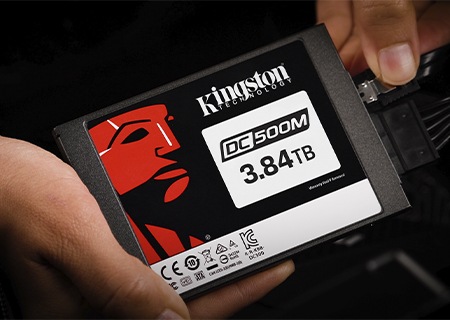Ask an Expert
Planning the right solution requires an understanding of your project and system requirements. Let Kingston's experts guide you.

As recording formats become more sophisticated, offering increasingly high-resolution, storage-intensive options, content creators need more and better storage options to handle the rigors of uploading, downloading, and editing such large video files – but how to optimize storage in this creative world?
Content creation, especially producing long-form video, requires a substantial amount of data storage. This data is valuable and must not only be stored but also backed up on a reliable system. Accounts are always at threat of hacking, and many creators run the risk of having their accounts permanently deactivated or deleted. In both instances, an unprepared creator can lose access to the files upon which they built their brand: assets without which regaining their following can be much harder, even impossible. Rather than court the possibility of professional and financial ruin, many creators of all sizes turn to network-attached storage (NAS) devices to organize and back-up the gigabytes or more of data that is their content.
There are many reasons why. NAS systems give creators flexible storage capacities that can grow with their data, and RAID (redundant array of independent disks) setups will protect their valuable data in case of drive failure. With 4k and 8k footage becoming increasingly common, high-speed connections such as Thunderbolt, 2.5GbE, and especially 10GbE, are necessary to reduce time spent transferring files to and from storage. The snap backups that NAS systems make easy are vital in insuring against accidental deletions. The backups also offer a degree of mitigation against ransomware attacks. Some select NAS systems integrate seamlessly with non-linear editing tools such as iMovie or Final Cut Pro X. QNAP is one such provider at the forefront of NAS provision.
Before content creators choose a NAS, they should consider the following issues:
Depending on the size of the content creator operation in question, different usage scenarios may be in effect. For example, a lone content creator will have a quite different setup to a production studio.

In these circumstances, as little as 20 to 30GB of NAS can suffice, depending on how much content is being created. Examples of products that this type of creator might use include:
This setup would come with 4 or 6 bays, a medium processor (such as the Intel Celeron), 2 x 2.5 Gigabit ports, and a standalone box chassis that fits under a desk. All QNAP NAS can be populated with either HDDs or SSDs, but normal HDD might be the preferred solution for this level of creator as it still nowadays the most cost-effective solution for high storage capacity.
In situations such as this, for example a marketing agency producing TV advertising content, or a music video production company, more robust storage capacity and high-speed editing is necessary. An agency such as this will use a combination of SSD and HDD or exclusively SSD. In use cases such as these, several workstations will be connected with a single NAS in the office. People collaborate on the NAS, using it as a platform. Everyone will have their own tasks to perform. One color-corrects and erases unwanted objects. One adds music. One splices the desired clips together. One changes the backgrounds or composites graphics. Hundreds of 1-to-5-minute clips will be produced over the lifespan of the NAS. Once the project is completed, the NAS saves the final content through a 10GbE connection to a larger server.
Product series that a small studio may decide to use for this purpose include the TS-x73A, and the TVS-x72XT. Both come with decent processor power for your usage scenario. The TS-x73A series offers two 2.5GbE ports, while the TVS-x72XT comes with 10GbE ports, two 1GbE ports, and two Thunderbolt 3 ports. Up to 64GB of RAM is available, and the products can be configured with 4, 6, and 8 bays. Depending on the drives you use, more than 100TB of storage is plausible.

A growing video production company, one that has previously leaned on multiple portable hard drives, may seek a solution to the issue of only one user being able to access a storage device at a time. The need for an organized and centralized storage solution that can provide access simultaneously for multiple PCs or Macs is a strong motivation to switch to NAS systems. This solution will allow for video editing without having to move the files over to the workstation. It also means that project archival is an easier process. NAS systems can potentially offer cost-efficiency over alternatives, which is beneficial to small and growing businesses.
More than a few large studios make use of the QNAP TVS-h1688X. It has a grand total of 16 bays, an Intel® Xeon® NAS with four 2.5 inch and twelve 3.5-inch trays, two 10GbE network ports, and four 2.5GbE network ports. The NAS can be configured in a RAID 6 format, to achieve fast read and write speeds that factor in capacity and data protection requirements. The high speed supplied enables simultaneous editing of videos stored on the NAS.
Since both SSDs and HDDs are compatible with the TVS-h1688X, some users may have the idea of using SSDs as cache, e.g., 4 SSDs and 12 HDDs in a 16-bay model. For this model, we would recommend 8 SATA SSDs in RAID 5, alongside 8 HDDs. SSD caches do not bring speed advantages in the case of sequential read/write. In video editing scenarios, data works differently than with databases holding many small files. Video files are large and must be read in a certain order. For content creators, we recommend using an SSD storage pool to edit in high speed and share data, using the second storage pool of HDDs to store the final product. Of course, this system obsoletes data transfer services such as WeTransfer.
Once a creator has finished deciding which model of NAS to purchase and the number of bays they need, the next question is what to fill those bays with.
The market offers a number of storage media options, meaning that it can be a challenge to select the optimal one for your situation. HDDs have been dominating the market for 30 years and retain their great popularity owing to the current SATA interface they use being implemented on a wide range of systems, from desktop PCs, to laptops, to servers and NAS.

In terms of price per gigabyte, HDDs are still the top choice. However, SSD adoption rates over the last few years have been increasing. The NAND Flash technology of SSDs offers exceptional performance compared to the mechanical spinning platter technology of HDDs. NAND Flash technology is still evolving, and SSD manufacturers such as Kingston have been bringing competitive new products to market, such as SSDs with higher storage capacities.
Increasingly, SSDs are competing with HDDs on price. What is more, the introduction of SATA-based SSDs only further illustrates the extent to which SSDs outperform HDDs: 550MB/s to 120MB/s. Even with the SATA bus limitations, it is common to see SATA-based SSDs outperform legacy HDD technology by 10-15 times when looking at overall system performance.
In addition to the performance, another element to take in consideration while selecting an SSD is the endurance. SSDs have a limited lifespan due to the nature of NAND Flash technology. Enterprise-class SSDs usually offer higher endurance than client SSDs, which is why we recommend opting for enterprise-class SSDs such as Kingston SSD DC series as a storage solution for NAS systems. This increased functionality heralds’ massive potential for NVMe storage devices, thanks to the higher efficiency, performance, and interoperability on a broad range of systems. Experts agree that the technology will become the new industry standard.
The different form factors of SSDs should also be considered. 2.5” drives are most common, but smaller form factors such as M.2 are increasingly popular. The latest models of NAS tend to have at least one socket for M.2 SSDs, meaning that users can insert 3.5” or 2.5” HDDs into the front bays to maximize storage capacity, while installing M.2 SSDs to improve NAS performance.
If you have questions about which SSDs or even which HDDs might be a good choice for a particular NAS, Kingston offers an Ask an Expert service with technical support on all manner of SSD and HDD decisions. We are happy to help, even with queries not directly about our products. And QNAP offers resources to prospective NAS system owners, such as its compatibility list for finding compatible drives, its guide on how to choose and upgrade the perfect NAS for you, and its product selector. Contact QNAP presales for more information.
It is vital to choose the correct technology partners when you are looking to optimize and increase your overall production. A partner that is more interested in upselling and meeting its quotas than in helping your business find the solution that will best enable your growth at the appropriate pace will ultimately fall short of your needs. Kingston is with you regardless of the scale of your purchase, and QNAP is similarly ready to deliver top-quality customer service for all clients, big and small alike.
#KingstonIsWithYou

Planning the right solution requires an understanding of your project and system requirements. Let Kingston's experts guide you.